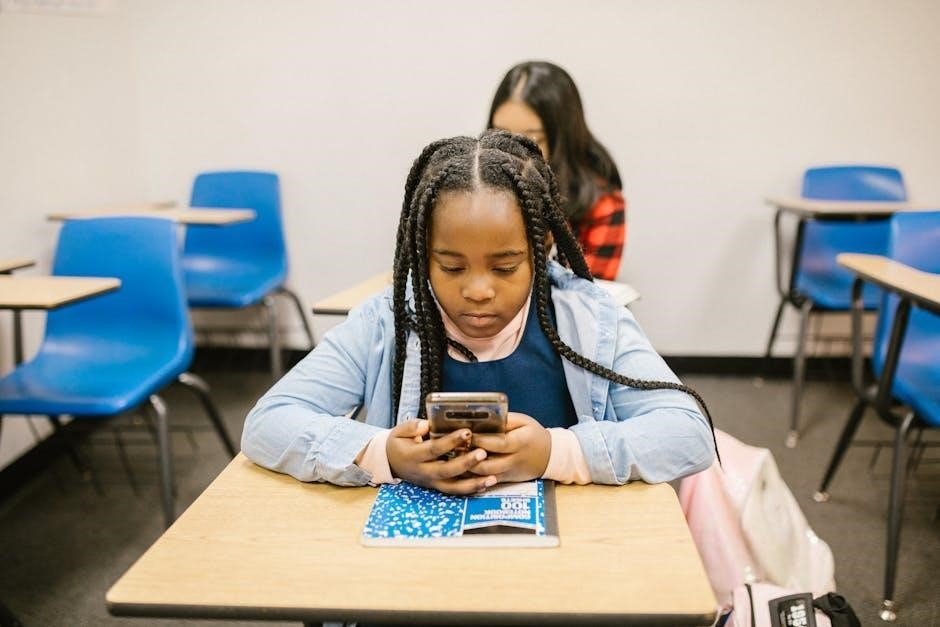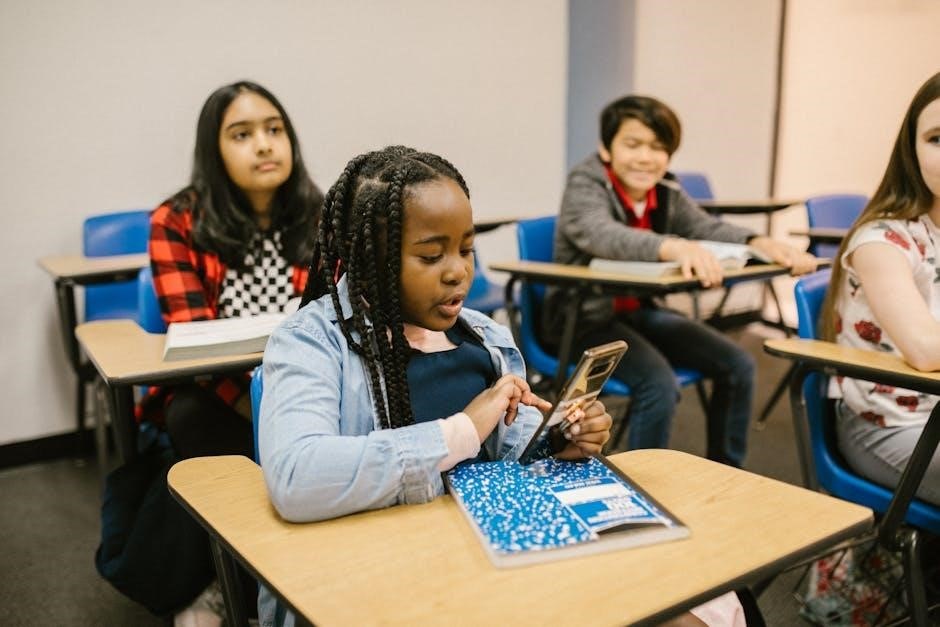The modern childhood‚ increasingly dominated by smartphones‚ faces a growing crisis. This shift from play-based activities to screen-based engagement raises concerns about the mental and social development of today’s youth‚ demanding a critical re-evaluation.

The Rise of Adolescent Mental Health Issues
The early 2010s marked a troubling period‚ witnessing a surge in adolescent mental health issues. Depression and anxiety rates climbed significantly‚ highlighting a potential link between new environmental factors and youth well-being.
Statistics on Depression and Anxiety in the 2010s
During the 2010s‚ studies revealed a concerning trend: depression and anxiety rates among adolescents in the United States experienced a marked increase. Data indicated a rise of over 50 percent in numerous research projects comparing the early 2000s to the period between 2010 and 2019. The suicide rate for girls aged 10-14 has risen by 130 in the United States in the last decade. These statistics underscore a significant shift in the mental health landscape of young people. This abrupt change has prompted investigations into potential contributing factors. Many believe that this change is a tipping point.
Jonathan Haidt’s Perspective
Jonathan Haidt argues that today’s environment is “hostile to human development.” He highlights the significant mental health decline among adolescents since the early 2010s. This is due to phone based childhood.
Haidt’s Argument: Hostile Environment for Child Development
Social psychologist Jonathan Haidt contends that the current environment in which children grow up is detrimental to their overall development. He points to the alarming rise in depression and anxiety rates among adolescents since the early 2010s. This coincides with the increased prevalence of smartphone use and screen time. Haidt suggests that this “phone-based childhood” deprives children of essential real-world experiences. These include free play‚ independent exploration‚ and face-to-face social interactions. He believes these experiences are crucial for building resilience‚ social skills‚ and emotional well-being. Haidt’s perspective underscores the need to re-evaluate how technology impacts child development.
The Anxious Generation: How the Great Rewiring of Childhood Is Causing an Epidemic of Mental Illness
Jonathan Haidt’s book‚ “The Anxious Generation‚” explores how the “great rewiring” of childhood‚ driven by smartphone proliferation‚ contributes to an epidemic of mental illness. He argues that excessive screen time and reduced real-world interaction disrupt normal human development. This “phone-based childhood” diminishes opportunities for crucial experiences like free play and independent exploration. These limitations‚ Haidt argues‚ lead to increased anxiety and depression among young people. He advocates for a cultural shift to prioritize real-world experiences. This includes promoting independence and limiting smartphone access‚ especially before adolescence. Haidt’s work highlights the urgent need to address the impact of technology on children’s mental health.
The Transition from Play-Based to Phone-Based Childhood
The shift from play-based to phone-based childhoods marks a significant change. It is blocking normal human development by displacing sleep‚ play‚ and face-to-face interaction‚ impacting children’s well-being.
Impact on Sleep and Arousal
The presence of screen-based media devices‚ especially in the bedroom‚ significantly disrupts sleep patterns in children and adolescents. This disruption is possibly due to the constant temptation to check devices or a conditioned response leading to heightened arousal. Longitudinal studies show a clear link between nighttime mobile phone use and subsequent poor sleep quality. The blue light emitted from screens interferes with melatonin production‚ further exacerbating sleep disturbances. Insufficient sleep can negatively affect cognitive function‚ mood regulation‚ and overall physical health. This highlights the importance of establishing phone-free bedtime routines to promote healthy sleep habits for young people and reduce the negative impact.
Loss of Free Play and Independence
The transition to a phone-based childhood significantly curtails opportunities for unstructured free play and independent exploration‚ which are essential for healthy development. Children are under-protected in the virtual world and over-protected in the real world. Free play fosters creativity‚ problem-solving skills‚ and social competence. These skills will help children overcome fear and fragility. With increased screen time‚ children miss out on crucial experiences of navigating the real world independently. This lack of independence can hinder the development of essential life skills‚ such as decision-making‚ risk assessment‚ and self-reliance. Encouraging unstructured activities is vital for promoting well-rounded development and preparing children for the challenges of adulthood.
The Role of Schools in Reversing the Trend
Schools play a vital role in reversing the trend of phone-based childhoods. Schools must come together and then schools must go phone-free. By implementing phone-free policies‚ schools can foster a healthier learning environment.
Step 1: Schools Must Come Together
To effectively combat the pervasive influence of phone-based childhoods‚ schools must first unite in a collaborative effort; Individual schools acting in isolation will struggle to make a significant impact. A collective commitment is essential to create a widespread cultural shift. This collaboration should involve sharing best practices‚ developing consistent policies regarding phone use‚ and supporting each other in the implementation of these policies.
Furthermore‚ schools must engage with parents and the wider community to foster a shared understanding of the importance of limiting screen time and promoting alternative activities. Only through a united front can schools hope to reclaim childhood from the grip of smartphones.
Step 2: Schools Must Go Phone-Free
Following the establishment of a united front‚ the next crucial step is for schools to implement comprehensive phone-free policies. This means creating an environment where phones are not allowed during the school day‚ including classrooms‚ hallways‚ and common areas. The goal is to minimize distractions and encourage students to engage with their surroundings and each other.
This may involve requiring students to store their phones in lockers or designated areas upon arrival and retrieve them at the end of the day. Clear and consistently enforced rules are essential to ensure compliance and create a culture of focused learning and social interaction. Going phone-free allows students to be free from the temptation of screen!
The Impact of Screen Time on Children
Excessive screen time significantly impacts children‚ affecting their sleep‚ social skills‚ and cognitive development. Studies reveal alarming statistics on the hours kids spend glued to their phones daily‚ raising serious concerns.
Hours Spent on Phones by Different Age Groups
The amount of time children spend on their phones varies significantly across age groups. According to a 2019 report from Common Sense Media‚ children aged eight to twelve who own phones spend nearly five hours a day using them. Teenagers‚ on the other hand‚ rack up almost eight hours of screen time daily. This substantial engagement with digital devices raises concerns about potential negative impacts on their well-being and development. The pervasive presence of screens in young lives necessitates a careful examination of its consequences. Understanding these usage patterns is the first step towards addressing the challenges of a phone-based childhood.

Cultural Shift and the Importance of Independence
A significant cultural shift has occurred‚ moving away from valuing childhood independence and towards increased parental supervision‚ often mediated by technology. This overprotection in the real world contrasts with underprotection in the virtual realm‚ creating an imbalance in children’s development. Jonathan Haidt argues that fostering independence is crucial for overcoming fear and building resilience. Children need opportunities for unstructured free play and exploration to develop essential life skills. Encouraging independence empowers them to navigate challenges and fosters a sense of self-reliance. Reversing the trend of overprotection and promoting independent exploration is vital for healthy child development.

Challenges and Counterarguments
Efforts to curb phone-based childhoods face challenges. Some argue the internet is “real life‚” and changing established tech habits is difficult. These views clash with concerns about developmental impacts‚ creating debate.
The Argument for the Internet as Real Life
A key counterargument is the perception of the internet as an integral part of contemporary life‚ not merely a virtual escape. Proponents argue that for today’s youth‚ online interactions‚ digital communities‚ and access to information are as real and impactful as offline experiences. Dismissing the digital realm disregards a significant portion of their social‚ educational‚ and emotional development.
Furthermore‚ the skills and mindsets acquired through online engagement‚ such as digital literacy‚ critical thinking‚ and adaptability‚ are deemed essential for navigating the modern world. Restricting access to these online environments could potentially hinder their ability to thrive in an increasingly digital future.
The Difficulty of Changing Established Habits
One of the biggest obstacles to reversing the trend of phone-based childhoods lies in the deeply ingrained habits of both children and parents. Smartphones have become ubiquitous tools for communication‚ entertainment‚ and even education‚ making it difficult to simply remove them from a child’s life.
For children‚ phones provide instant gratification and a sense of connection with their peers; Taking that away can lead to feelings of isolation and resentment. Similarly‚ parents may find it challenging to break the habit of using phones as pacifiers or babysitters‚ especially in today’s busy world. Overcoming these established patterns requires a concerted effort and a strong commitment from all parties involved.

Potential Solutions and Strategies
Addressing the crisis requires multifaceted strategies‚ including setting age limits for smartphone use and promoting unstructured free play. These solutions aim to foster healthier development and a more balanced childhood.
Setting Age Limits for Smartphone Use
Establishing age limits for smartphone use emerges as a crucial strategy in mitigating the adverse effects of phone-based childhoods. One persuasive voice suggests no smartphones before 14‚ advocating for flip phones as alternatives. This approach mirrors the experiences of millennials‚ who effectively communicated and socialized using simpler technology.
Implementing such limits could safeguard younger children from the addictive nature of smartphones and the potential for social isolation. By delaying access‚ children gain more time for crucial real-world interactions‚ fostering social skills and emotional resilience. The goal is to shift the culture‚ and schools must come together to accomplish this.
Promoting Unstructured Free Play
Reintroducing unstructured free play is vital to combating the negative impacts of phone-based childhoods. Championing this type of play resonates with the commitment to fostering environments where children can explore‚ create‚ and socialize without the constraints of screens. Unstructured play allows children to develop essential social skills and overcome fear.
The transition from play-based childhoods to phone-based childhoods is harmful. Such play fosters independence‚ problem-solving abilities‚ and resilience‚ all crucial for healthy development. Encouraging activities like outdoor exploration‚ imaginative games‚ and social interaction helps children develop essential life skills. Prioritizing free play is essential for ensuring a balanced and enriching childhood experience.
As we grapple with the implications of a phone-based childhood‚ it’s crucial to re-evaluate our relationship with screens. Jonathan Haidt’s call to end the phone-based childhood highlights the urgency of addressing this issue. The transition towards excessive screen time has come at the expense of free play and childhood independence.
We must acknowledge the potential harm to children’s mental health and overall well-being. Promoting a more balanced lifestyle that prioritizes real-world interactions‚ outdoor activities‚ and unstructured play is essential. By consciously limiting screen time and fostering a culture that values human connection‚ we can pave the way for healthier and more fulfilling childhoods.